Intel Xeon E5-2697 v2 and Xeon E5-2687W v2 Review: 12 and 8 Cores
by Ian Cutress on March 17, 2014 11:59 AM EST- Posted in
- CPUs
- Intel
- Xeon
- Enterprise
Real World CPU Benchmarks
Rendering – Adobe After Effects CS6: link
Published by Adobe, After Effects is a digital motion graphics, visual effects and compositing software package used in the post-production process of filmmaking and television production. For our benchmark we downloaded a common scene in use on the AE forums for benchmarks and placed it under our own circumstances for a repeatable benchmark. We generate 152 frames of the scene and present the time to do so based purely on CPU calculations.
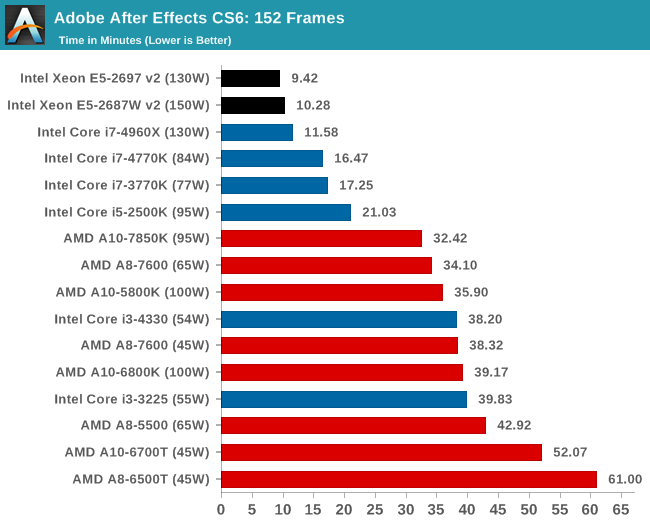
With AE6 being an optimized software package, more cores and threads rather than more MHz makes sense in our test.
Compression – WinRAR 5.0.1: link
Our WinRAR test from 2013 is updated to the latest version of WinRAR at the start of 2014. We compress a set of 2867 files across 320 folders totaling 1.52 GB in size – 95% of these files are small typical website files, and the rest (90% of the size) are small 30 second 720p videos.
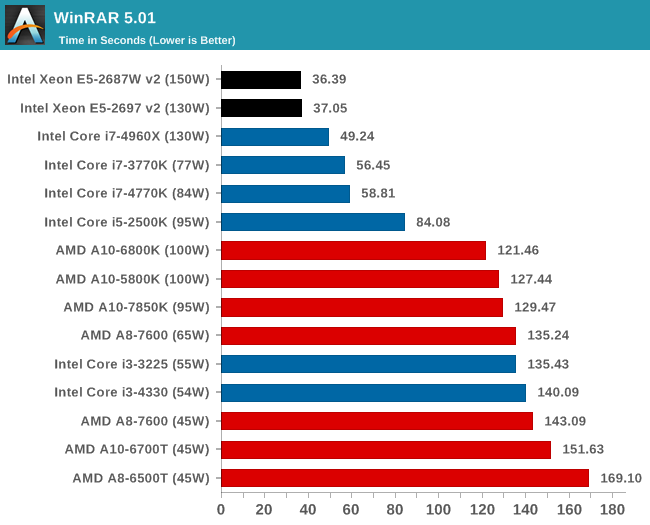
Due to the variable nature of the WinRAR test, our Xeons come out on top but it is hard to choose between them.
Image Manipulation – FastStone Image Viewer 4.9: link
Similarly to WinRAR, the FastStone test us updated for 2014 to the latest version. FastStone is the program I use to perform quick or bulk actions on images, such as resizing, adjusting for color and cropping. In our test we take a series of 170 images in various sizes and formats and convert them all into 640x480 .gif files, maintaining the aspect ratio. FastStone does not use multithreading for this test, and thus single threaded performance is often the winner.
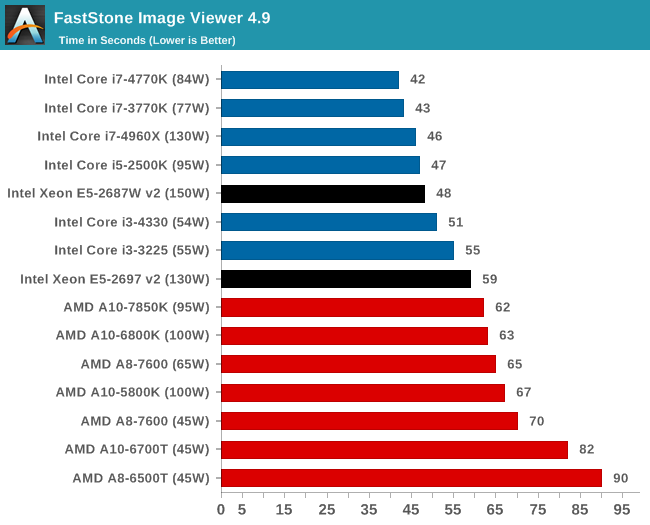
FastStone is a single threaded application where IPC and MHz matter. As a result, the newest architectures and platforms do better here than the Ivy Bridge-E based Xeons.
Video Conversion – Xilisoft Video Converter 7: link
The XVC test I normally do is updated to the full version of the software, and this time a different test as well. Here we take two different videos: a double UHD (3840x4320) clip of 10 minutes and a 640x266 DVD rip of a 2h20 film and convert both to iPod suitable formats. The reasoning here is simple – when frames are small enough to fit into memory, the algorithm has more chance to apply work between threads and process the video quicker. Results shown are in seconds and time taken to encode.

When going through lots of small frames, our XVC test working on one file prefers cores and threads over MHz.

When the workload has some room to grow with larger frames, segments of each frame can be dispatched to cores more approprately and the 12-core Xeon comes out on top.
Video Conversion – Handbrake v0.9.9: link
Handbrake is a media conversion tool that was initially designed to help DVD ISOs and Video CDs into more common video formats. The principle today is still the same, primarily as an output for H.264 + AAC/MP3 audio within an MKV container. In our test we use the same videos as in the Xilisoft test, and results are given in frames per second.
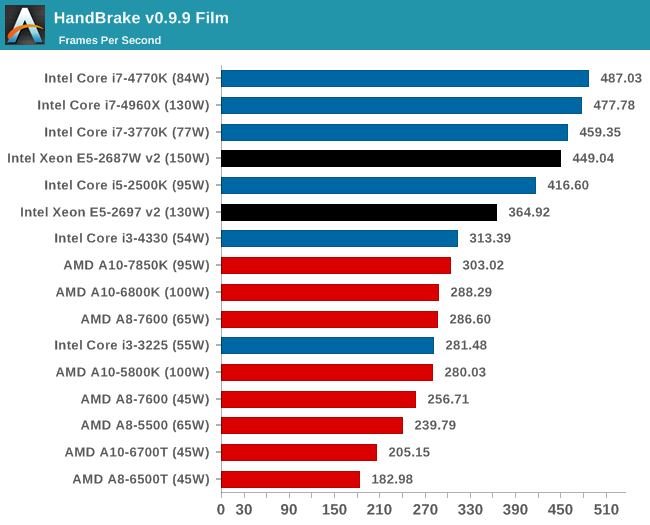
Similar to the XVC test, when the frames are small the software has to fight against thread dispatch of smaller pieces that get in the way of opening up the trottle.
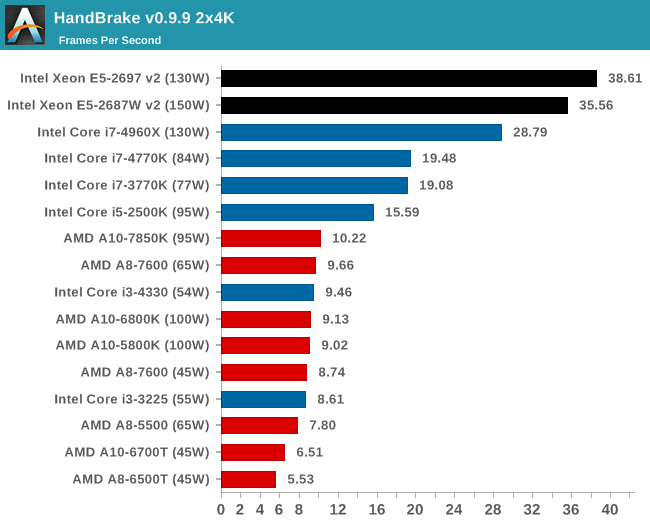
Move to larger frames again and the Xeons can use their full force. Cores over MHz wins here.
Rendering – PovRay 3.7: link
The Persistence of Vision RayTracer, or PovRay, is a freeware package for as the name suggests, ray tracing. It is a pure renderer, rather than modeling software, but the latest beta version contains a handy benchmark for stressing all processing threads on a platform. We have been using this test in motherboard reviews to test memory stability at various CPU speeds to good effect – if it passes the test, the IMC in the CPU is stable for a given CPU speed. As a CPU test, it runs for approximately 2-3 minutes on high end platforms.
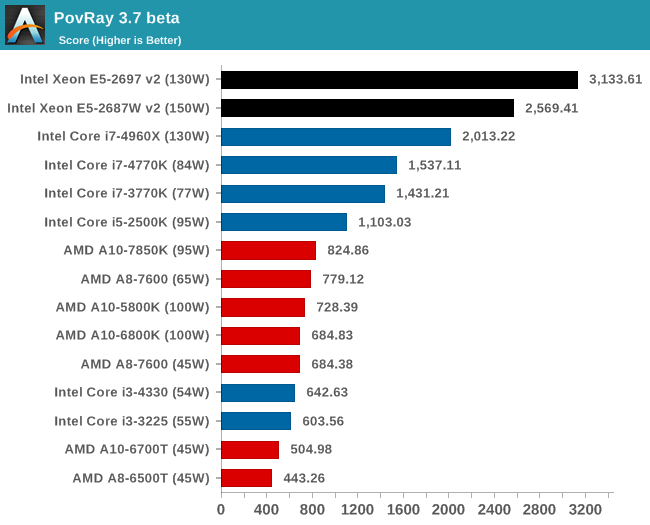
PovRay becomes an embarrassingly parallel benchmark where cores x frequency come out on top. This pattern of results is a common sight in our synthetic testing.










71 Comments
View All Comments
Ian Cutress - Monday, March 17, 2014 - link
Corrected :) The test setup for the A10-7850K is the same as the Kaveri review. ASRock FM2A88X Extreme6+ with extra cooling, 2x8GB DDR3-2133 (i.e. rated processor speed).Nintendo Maniac 64 - Monday, March 17, 2014 - link
So stock clocks with turbo enabled on Win7 64bit SP1 w/ core parking update?Ian Cutress - Monday, March 17, 2014 - link
Correct.mattchid - Monday, March 17, 2014 - link
I have two 2697v2 I was gifted, and while I'm only running one on an x79 MB, I have two questions I can't find answers to elsewhere on the 2697 v2:1. Is the memory limited to 1866, even on motherboards supporting higher overclocks? I have tried to run memory above that speed (1866 memory that usually over clocks well) and the computer refuses to boot past the bios at that speed.
2. What would the performance gains be with both installed, in reference to multithreaded activities, like rendering, or even more rudimentary, like x264 or handbrake conversion? I would guess with single threaded activity, there would be no difference in performance, than one CPU.
psyq321 - Tuesday, March 18, 2014 - link
I have tested two generations of 2697 v2 (C0 and C1 stepping) and both refuse to accept anything above 1866 MHz. Practically, my old workhorse (dual 2687W) was much better in that regard and could run DDR3 @2133 MHz without any trickery.Although the CPU platforms (JakeTown and IvyTown) are pin-compatible for the EP series, high-core-count (HCC) EP IvyTowns have two separate memory controllers and I suppose this introduces regressions when it comes to "overclockability" of the RAM.
As for the #2, if you are running NUMA-aware multithreaded software that can spawn 24 or 48 threads, you can expect almost linear performance scaling with dual-CPU setups.
If the software is not NUMA aware, then there are performance drops that can be 30-50% (so you get, maybe, 1.5x speedup). If the software cannot get more than, say, 8 threads, then there would be no speedups (but even in this case you can start two separate processes and do two encoding sessions at once, and regain the 2x speedup)
CamdogXIII - Monday, March 17, 2014 - link
Typo in the gaming benchmarks. Under BF4, the button selection heading reads company of heroesIan Cutress - Tuesday, March 18, 2014 - link
Corrected :)iwod - Monday, March 17, 2014 - link
This doesn't really answer any question about the State of Xeon.So what exactly is difference between a Xeon E3- v3 and a Normal Top End Haswell Chip?
We have Broadwell soon ( in a few months? ) Are we suppose to get new Haswell E5 too? Isn't the Xeon E5 always one year behind the desktop counterpart, or are they slipping even more?
JlHADJOE - Monday, March 17, 2014 - link
Xeon E3 has ECC support, which is pretty cool.venk90 - Tuesday, March 18, 2014 - link
Ian, Could you post the AMD Kaveri CPU and GPU numbers to the respective bench sections of this website ? Makes comparisons a lot easier.